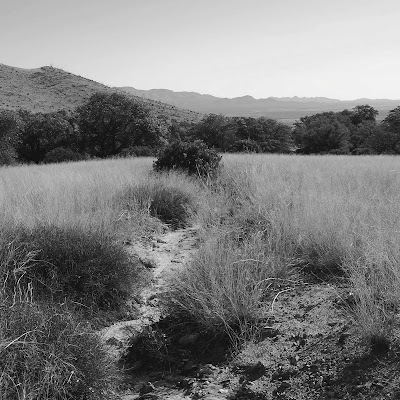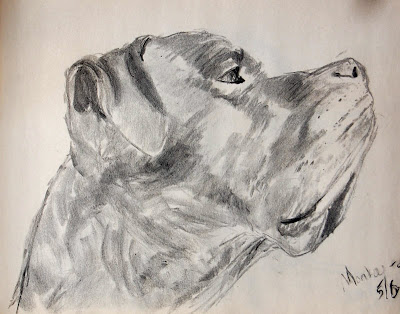When I was staying with my sister in Bisbee this winter, I shared the house with her pack of fur-units, as I like to call them: 3 cats and a black brindle boxer named Monkey. Unlike the cats, whose entire existence revolved around their stomachs and figuring out obnoxious new means to obtain food, Monkey existed for the purpose of going on walks. Or, better yet - a ride in the car that would lead to something better than a walk: an Outdoor Adventure. Outdoor Adventures take place in new locations, usually off-leash, with sights and smells that don't exist along the usual walk around town. For a dog, there is nothing better than this.
Monkey - charcoal study #1
9x12" on newsprint pad
My sister isn't much of a hiker like I am, and she also didn't have the free time to go out like I did. When I started taking Monkey on hikes on the local trails, it didn't take him long at all to figure out the "pre-hike procedure", which would involve me first getting dressed in outdoor clothing and hiking boots. After staring at me to be sure of my intentions, he would go over and pull his leash and collar off of their storage location on the kitchen wall, and drag them over to me on the floor. And then he'd stand there, looking at me with a hopeful, pleading, look in his eyes. If he saw me grab my backpack, camera and tripod, he would start whining, because those things definitely meant an Outdoor Adventure, and Ride in the Car, vs. a mere walk. When I would tell him he could come with me, he would start jumping up and down, doing what I called the "boxer dance". It was hilarious seeing him get so excited.
I brought him out with me on numerous occasions on hikes and photo shoots, mostly because I was a sucker for his act, but also because of this unfortunate reality:
No es bueno
Sign at the trailhead of the Crest trail in the Huachucas
In addition to his imposing looks, Monkey would have gone after anyone attacking me, as I was part of his pack. Thankfully, we only ever crossed paths with other hikers, so this was never an issue. He wasn't able to go on runs anymore, but could still hike 5-6 miles, which he did on the day we hiked the Crest trail. I'd bring his water bottle, and he loved to drink water as it was poured directly from the bottle into his mouth.
Monkey on the Crest trail - March 18, 2010
A smiling, happy dog!
Roxanne told me that on the day I left Bisbee, Monkey was out of sorts, and kept going into my old bedroom, looking for me.

Monkey - charcoal study #2
9x12"
My sister got Monkey from a rescue group about 5 years ago, and his age was guessed to be around 3 years at that time. So, he was far from a young dog, especially as boxers go. Shortly after I left for Tucson, he started having some increasing problems with his GI system. An evaluation revealed a large tumor in his stomach that was likely malignant, as well as severe pancreatitis. The vet told my sister he could probably still do okay on some medications, at least for a while. So, she sunk hundreds of dollars for medications and tests.
Monkey - charcoal study #3
9x12"
Alas, his condition continued to deteriorate, including trouble breathing, so on April 29, Roxanne had him put to sleep. Even though he wasn't my dog, I grew quite fond of him and he certainly enriched my time in Bisbee much as I am sure I enriched his for the 4 months I was there. I'm glad I wasn't there at the time; seeing the life go out of a living creature is always sad for me, especially one that was so happy and full of life not too long before.
Monkey - charcoal study #4
9x12"
A few days before I left, I took several photos of Monkey, thinking that I'd like to do a painting of him for my sister. I also had some photos taken earlier, of him with a favorite stuffed toy, a French-speaking rabbit:

Monkey with Henri - charcoal gesture sketch
Since my sister's birthday is coming up in a few days, a portrait of Monkey seemed most fitting. I've found that repetition and multiple studies of a particular subject is the best way to do it justice, so I've been doing charcoal sketches based on the photos I took back in March. Getting my drawing skills back up to a respectable level is another reason. I'm still undecided as to whether I'll do a head portrait, or one based on the gesture sketch above.

Monkey - charcoal study #5
So, Monkey - this post is for you. May you continue to have Outdoor Adventures wherever you may be. I'll miss you, buddy.






















































